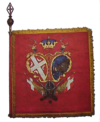Jovan Kursula
- View a machine-translated version of the Serbian article.
- Machine translation, like DeepL or Google Translate, is a useful starting point for translations, but translators must revise errors as necessary and confirm that the translation is accurate, rather than simply copy-pasting machine-translated text into the English Wikipedia.
- Do not translate text that appears unreliable or low-quality. If possible, verify the text with references provided in the foreign-language article.
- You must provide copyright attribution in the edit summary accompanying your translation by providing an interlanguage link to the source of your translation. A model attribution edit summary is
Content in this edit is translated from the existing Serbian Wikipedia article at [[:sr:Јован Курсула]]; see its history for attribution. - You may also add the template
{{Translated|sr|Јован Курсула}}to the talk page. - For more guidance, see Wikipedia:Translation.


Jovan Petrović (Serbian Cyrillic: Јован Петровић, 1768–16 August 1813), known as Jovan Kursula (Јован Курсула), was a Serbian vojvoda (commander) that participated in the Serbian Revolution.
Biography
Petrović was born in Donja Gorevnica, in the Rudnik okrug,[1] near Čačak, at the time part of the Sanjak of Smederevo (now Serbia). Both his parents, Velimir and Magdalena, had ancestry from Drobnjaci in what is today Montenegro. After his father's death his mother remarried in the village of Cvetke near Kraljevo, bringing Jovan with her. Kursula had brown hair, light skin, full cheeks, youthful looks, broad shoulders.[1] He did not carry his sabre from his waist, as did most others, but "over his shoulder, as it was easier to pull out", as he was a master of swordsmanship.[2] He was one of the Rudnik nahija commanders, alongside Lazar Mutap, Arsenije Loma, Milić Drinčić and Milan Obrenović. At the Battle of Varvarin he had a duel against an Ottoman commander known as the "Black Arab" (Crni arapin). He died from wounds from the Battle of Deligrad.

Legacy
A Yugoslav Partisan detachment in Kraljevo named after him was established in 1941.[3] He has several primary schools named after him throughout Serbia, as well as streets in Čačak, Vračar, Niš, Užice, Gornji Milanovac, Zaječar and Zrenjanin.
See also
References
- ^ a b Marković & Pantović 1996, p. 119.
- ^ Predrag Milošević (1989). Sveti ratnici : borilacke vestine u Srba. ISBN 9788636702611.
Тако Јован Курсула није носио сабљу онако како се носи - о бедрима »него затурену на раме, како му је лакше по- тегнути је«
- ^ Srboljub Đ Stamenković (2002). Geografska enciklopedija: naselja Srbije. Geografski fakultet. p. 280. ISBN 9788682657149.
... коме је на месту званом "Партизанске колибе" јула 1941. год. формиран Кра- љевачки партизански одред "Јован Курсула"
Sources

- Dugalić, Miroljub (2013-09-03). "Јован Курсула – Мегданџија без титуле и власти". Magacin.[permanent dead link]
- Marković, Radul; Pantović, Miloljub S. (1996). Donja Gorevnica: zemlja i ljudi. Odbor za proučavanje sela SANU. pp. 119–121.
- v
- t
- e
- Đorđe Petrović-Karađorđe
- Uzun-Mirko Apostolović
- Ilija Barjaktarović
- Anta Bogićević
- Mina Bimbaša
- Đura Brničanin
- Pavle Cukić
- Vasa Čarapić
- Ilija Čarapić
- Stojan Čupić
- Sava Dedobarac
- Aćim Doljanac
- Dimitrije Đorđević
- Todor-Toša Đorđević
- Stanoje Glavaš
- Jovan Gligorijević-Zeka Buljubaša
- Hadži-Prodan Gligorijević
- Nikola Grbović
- Petar Ičko
- Jovan Jančić-Sarajlija
- Jakov Jakšić
- Stojan Karadžić
- Janko Katić
- Ivan-Ivo Knežević
- Vreta Kolarac
- Cincar-Marko Kostić
- Naum Krnar
- Marko Krstić
- Dimitrije Kujundžić
- Jovan Kursula
- Milosav Lapovac
- Luka Lazarević
- Raka Levajac
- Arsenije Loma
- Paulj Matejić
- Sima Marković
- Tomo Milinović
- Mladen Milovanović
- Mateja Nenadović
- Sima Nenadović
- Jakov Nenadović
- Petar Nikolajević-Moler
- Dositej Novaković
- Petar Novaković-Čardaklija
- Đorđe Obradović-Ćurčija
- Jovan Obrenović
- Miloš Obrenović
- Dragan Papazoglu
- Dimitrije Parezan
- Pavle Popović
- Milutin-Era Petrović
- Ilija Strelja
- Hajduk-Veljko Petrović
- Radič Petrović
- Cincar-Janko Popović
- Mihailo Radović
- Tanasko Rajić
- Old Rashko
- Antonije Ristić-Pljakić
- Milutin Savić-Garašanin
- Čolak-Anta Simeonović
- Jovan Simić Bobovac
- Stevan Sinđelić
- Nikola Smiljanić
- Miloš Stojićević Pocerac
- Milenko Stojković
- Đorđe Šagić
- Petar Teodorović-Dobrnjac
- Miloje Todorović
- Milosav Zdravković-Resavac
- Vuča Žikić
- Nikola Ziković
- Kara-Marko Vasić
- Konda Bimbaša
- Toma Vučić Perišić
- Vujica Vulićević










